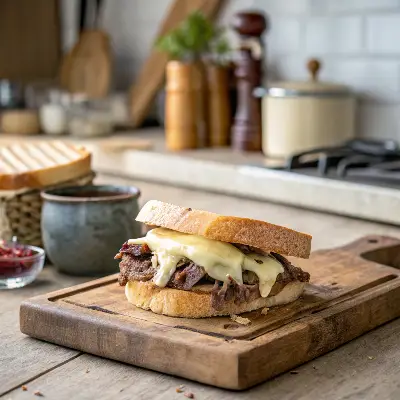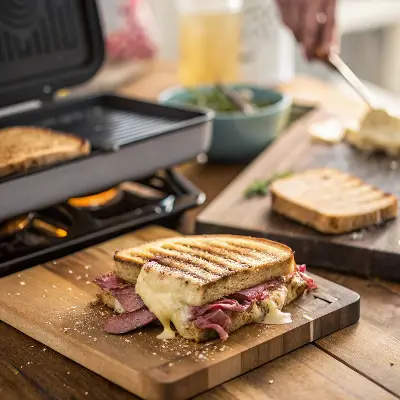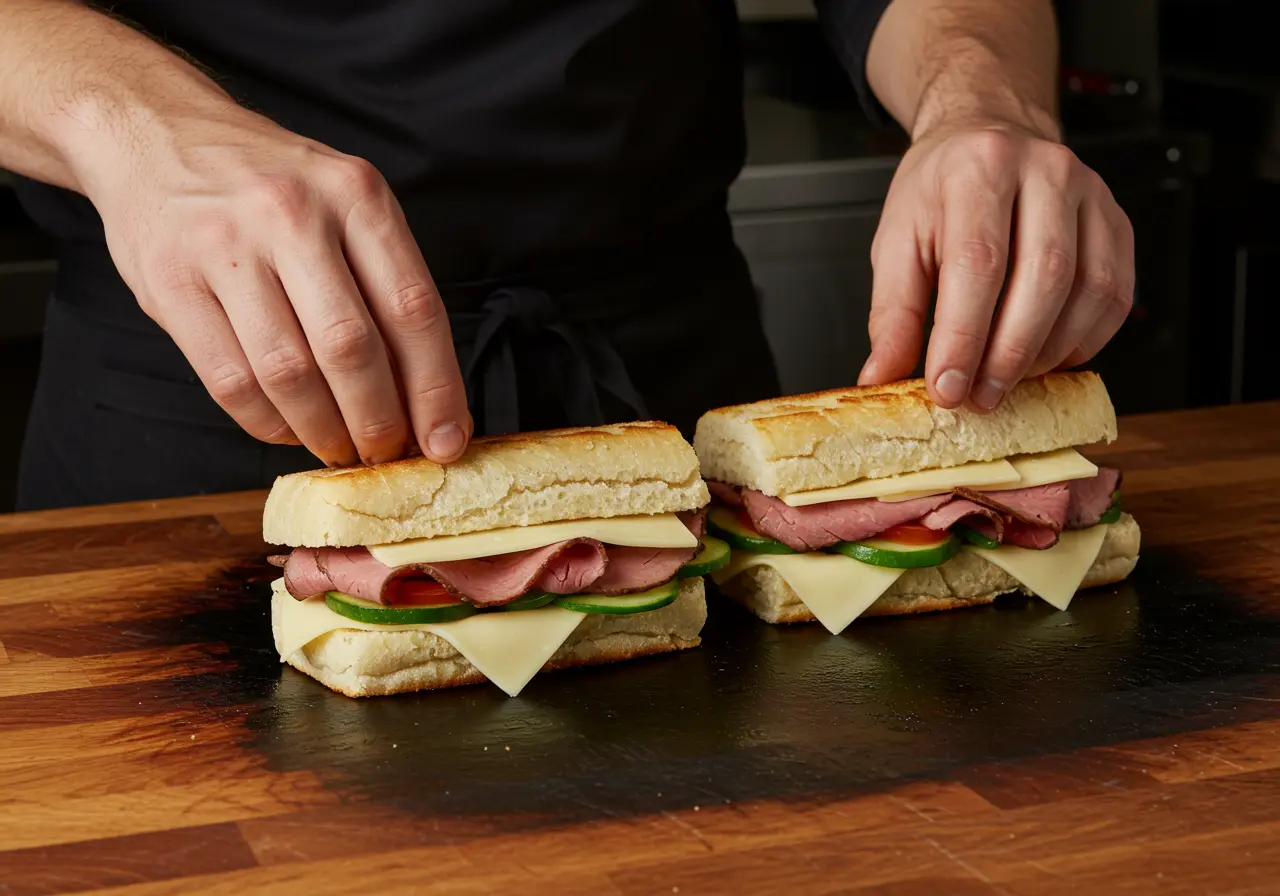What kind of cheese goes with roast beef? It’s a question that many food lovers ask when crafting the perfect sandwich or planning a mouthwatering meal. Pairing cheese with roast beef isn’t just about adding flavor—it’s about creating a balance of textures and tastes that elevate the dish to a whole new level. Let’s dive into the best cheeses for roast beef and how to pair them flawlessly.
Table of Contents
What Kind of Cheese Goes with Roast Beef? Perfect Pairings
When you think about roast beef, what comes to mind? Its rich, savory flavor and juicy texture, right? But what kind of cheese goes with roast beef to make it truly unforgettable? Cheese can add creaminess, tanginess, or even a bit of sharpness. Together, they create a perfect balance of flavors and textures.
But it’s not as simple as just throwing any cheese on there. To figure out what kind of cheese goes with roast beef, you need to consider flavor compatibility, texture, and how well the cheese melts or holds up when paired with this delicious meat.

Why Pair Cheese with Roast Beef?
So, why is cheese such a popular choice with roast beef? There are a few reasons:
- Balance of Flavors: Roast beef has a deep, savory flavor. Cheese can bring sweetness, tanginess, or nuttiness that balances it out.
- Texture Contrast: A creamy or gooey cheese adds softness to the chewy texture of beef.
- Melting Magic: If you’re making a hot sandwich or dish, a good melting cheese adds that irresistible goo factor.
Popular Cuts of Roast Beef and Their Characteristics
Before jumping into cheese pairings, it helps to know the type of roast beef you’re working with. Each cut has its own unique flavor and texture:
- Top Round or Bottom Round: Lean cuts with a mild flavor.
- Ribeye Roast: Rich, marbled, and full of flavor.
- Sirloin Tip Roast: Slightly firmer but still tender when cooked right.
The cut you choose can influence your cheese selection. A milder roast might pair better with a stronger cheese, while a rich, fatty cut like ribeye works well with lighter, creamy options.
The Basics of Cheese Pairing
Pairing cheese with roast beef isn’t rocket science, but there are a few basic principles to keep in mind:
Understanding Cheese Textures and Flavors
Cheeses come in all kinds of textures, from soft and creamy to hard and crumbly. Their flavors can be mild, tangy, nutty, or sharp. For roast beef, think about the balance:
- Soft cheeses like brie are great for their creaminess.
- Sharp cheeses like cheddar add a bold flavor punch.
- Tangy cheeses like blue cheese stand out against rich beef.
Complementary vs. Contrasting Pairings
When pairing cheese with roast beef, you have two main strategies:
- Complementary Pairing: Match similar flavors for harmony. For example, creamy Havarti complements the smoothness of a lean roast beef.
- Contrasting Pairing: Go bold and pair opposites. Tangy blue cheese with rich roast beef is a classic example.
Best Cheese Choices for Roast Beef Sandwiches
Roast beef sandwiches are a favorite for good reason—they’re hearty, delicious, and endlessly customizable. But the cheese you choose can make or break the experience.
Classic Choices: Swiss and Provolone
Swiss cheese is a go-to for roast beef. Its mild, nutty flavor doesn’t overpower the beef, and it melts beautifully. Provolone is another classic—it’s slightly sharp and smoky, making it perfect for both cold and hot sandwiches.
“Swiss cheese is like the safe bet of roast beef pairings—it’s dependable, versatile, and always delicious.”
Sharp and Tangy Options: Cheddar and Blue Cheese
If you’re in the mood for something with more zing, sharp cheddar is a fantastic choice. It’s bold enough to stand up to the beef’s flavor without overwhelming it.
Blue cheese, on the other hand, is for the adventurous. Its tangy, funky flavor contrasts beautifully with roast beef, creating a flavor explosion in every bite.
Mild and Creamy Selections: Havarti and Muenster
For those who prefer a smoother, creamier texture, Havarti and Muenster are excellent options. They’re mild in flavor, which allows the beef to take center stage, but they still add a subtle richness to each bite.
Unique Pairings: Brie and Gruyère
Looking to step up your roast beef game? Try brie or Gruyère. Brie adds a luxurious creaminess and a touch of sweetness, while Gruyère brings a nutty, slightly sweet flavor that pairs beautifully with beef.
“Pairing roast beef with brie? That’s like turning your sandwich into a gourmet masterpiece.”

What Kind of Cheese Goes with Roast Beef in Hot Dishes?
Hot roast beef dishes, like paninis, melts, or baked casseroles, bring a whole new level of comfort food to the table. When heat enters the equation, the way cheese melts becomes a big deal. Let’s look at some of the best choices for hot dishes and why they work so well.
Melting Marvels: Gouda and Fontina
Gouda is a superstar when it comes to hot dishes. Its smooth, creamy melt and slightly sweet, nutty flavor pair perfectly with the savory richness of roast beef. Gouda works beautifully in paninis or baked sliders, offering just the right amount of stretch and flavor.
Fontina, on the other hand, is a bit more subtle but equally impressive. Its mild, buttery flavor melts like a dream, making it ideal for dishes like French dips or open-faced roast beef melts.
Spicy Additions: Pepper Jack and Monterey Jack
If you like a little heat, Pepper Jack is the way to go. Its creamy texture and spicy kick add a fun twist to roast beef dishes, especially in tacos or quesadillas.
Monterey Jack, while milder, still delivers a smooth and creamy melt that enhances any roast beef dish. It’s particularly good in layered casseroles or cheesy baked subs.
Common Problems When Choosing Cheese for Roast Beef
Pairing cheese with roast beef isn’t always straightforward. Sometimes, the flavors don’t work together, or the cheese doesn’t melt as expected. Here are some common problems and how to fix them.
Overpowering the Beef Flavor
One of the most common mistakes is choosing a cheese that’s too strong for the roast beef. While bold cheeses like blue cheese are delicious, they can easily dominate the dish if not balanced properly.
Incompatibility with Condiments
Condiments like horseradish, mustard, or mayonnaise play a big role in roast beef dishes. Some cheeses clash with these flavors, leading to a less-than-stellar meal. For instance, tangy cheeses may not pair well with the sharpness of mustard.
Balancing Fat Content
Roast beef, especially cuts like ribeye, can be quite rich. Adding a heavy cheese might make the dish feel too greasy or overwhelming. On the flip side, a leaner cut of beef might need a creamier cheese to avoid feeling dry.
Solutions to Common Pairing Problems
For every problem, there’s a fix. Let’s address these pairing pitfalls and turn them into opportunities for deliciousness.
Tips for Finding the Perfect Flavor Balance
To avoid overpowering the beef, opt for mild or medium-strength cheeses if your beef has a strong flavor. For leaner, milder cuts, feel free to experiment with bolder cheese options.
A simple way to test compatibility is by trying a small bite of roast beef with the cheese before committing to a full dish.
Pairing Cheese with Bread and Condiments
Your choice of bread and condiments can make or break the pairing. For example:
- Mustard-Based Condiments: Pair with creamy, mild cheeses like Havarti to avoid clashing flavors.
- Horseradish Sauce: Go with a sharp cheese like cheddar to stand up to the boldness.
- Rich, Buttery Breads: Use tangy or nutty cheeses like Gruyère for a balanced bite.
“Think of the roast beef, cheese, and condiments as a team—each should bring something unique to the plate without stealing the spotlight.”

Regional Variations in Cheese and Roast Beef Pairings
Did you know that cheese and roast beef pairings can differ widely depending on where you are? From American classics to European gourmet trends, there’s a world of flavor to discover.
American Favorites
In the U.S., roast beef sandwiches often feature Swiss cheese or provolone, and they’re almost always served on soft, hearty bread like hoagies or ciabatta. Regional variations like Philly cheesesteaks use a melty cheese sauce for an over-the-top indulgence.
European Inspiration
Across the pond, European pairings lean toward stronger, more complex flavors. Think roast beef with Stilton or sharp English cheddar in the UK, or roast beef with creamy brie in France.
Gourmet Pairing Trends
Modern chefs love experimenting with unexpected combinations. For example, pairing roast beef with smoked gouda or aged asiago adds a gourmet twist to traditional dishes.
Vegetarian and Vegan Alternatives
If you’re catering to dietary preferences, there are plenty of vegetarian and vegan options that still deliver great flavor.
Plant-Based Cheese Options
Vegan cheeses have come a long way. Nut-based options like cashew brie or almond cheddar offer creaminess and flavor that mimic traditional cheeses, making them perfect for plant-based roast beef substitutes.
Matching Flavors for Meatless Roast Beef Substitutes
For vegetarian roast beef alternatives like jackfruit or seitan, go with cheeses that complement their flavor profiles. A smoky vegan gouda, for example, pairs beautifully with BBQ jackfruit “beef.”
Hosting a Roast Beef and Cheese Tasting Event
If you love the idea of experimenting with different roast beef and cheese combinations, why not host a tasting event? It’s a fun, interactive way to try new flavors and impress your friends or family. Here’s how to make it a hit.
Choosing a Variety of Cheeses and Accompaniments
The first step to a successful tasting event is selecting a range of cheeses. Aim for diversity to give everyone a chance to explore different flavors and textures:
- Mild Cheeses: Havarti, Monterey Jack, or Swiss.
- Sharp Cheeses: Aged cheddar or blue cheese.
- Creamy Cheeses: Brie or camembert.
- Smoked Cheeses: Smoked gouda or provolone for a bold twist.
Complement the cheeses with accompaniments like sliced roast beef, crusty bread, crackers, and condiments such as mustard, horseradish, or chutney. Don’t forget pickles and olives for a tangy contrast!
“A great pairing event is like a symphony of flavors—each component plays its part in harmony.”
Presentation Tips for Maximum Appeal
How you present your spread can make a big difference. Arrange your roast beef and cheese on a large charcuterie board with labels for each item. Use small bowls for condiments and scatter colorful garnishes like fresh herbs or dried fruits for visual appeal.
Fun Activities to Engage Guests
To make the event interactive, consider these activities:
- Tasting Cards: Provide cards for guests to jot down their favorite combinations.
- Cheese and Beef Quiz: A lighthearted trivia game about pairing rules.
- DIY Sandwich Station: Let everyone create their own roast beef and cheese masterpiece.
Final Thoughts on Roast Beef and Cheese Pairing
Pairing cheese with roast beef is all about finding the right balance of flavors and textures. But at the end of the day, it’s also about having fun and discovering what works for your taste buds.
Experimentation and Personal Preferences
While there are classic pairings that work well for a reason, don’t be afraid to experiment. Maybe you love the combination of spicy pepper jack with a sweet chutney or prefer a simple, comforting pairing of roast beef and creamy Havarti.
“In the world of food, rules are more like guidelines. The best combinations are the ones that make you say, ‘Wow, that’s delicious!’”
Encouraging Creativity in Your Pairings
Here are some creative ideas to inspire your next roast beef and cheese adventure:
- The Sweet and Savory Combo: Pair roast beef with brie and a dollop of fig jam on crusty bread.
- The Bold and Spicy Melt: Use roast beef, pepper jack, and a spicy sriracha mayo on a toasted roll.
- The Gourmet Wrap: Combine thinly sliced roast beef, Gruyère, and arugula in a spinach wrap.
FAQs About Roast Beef and Cheese Pairing
Can I use vegan cheese for roast beef dishes?
Absolutely! There are plenty of plant-based cheese options like almond cheddar or cashew brie that work wonderfully with meat or vegetarian alternatives like jackfruit.
What’s the best cheese for a cold roast beef sandwich?
Swiss, provolone, or Havarti are great for cold sandwiches. They’re mild enough to let the roast beef shine while adding creaminess.
How can I avoid overpowering the flavor of roast beef with cheese?
Stick to mild or medium-strength cheeses if you’re working with a strong-flavored beef cut. Always aim for balance!
Conclusion
Pairing cheese with roast beef is an art that combines creativity and flavor science. Whether you stick to classics like Swiss and provolone, experiment with bold choices like blue cheese, or try melting marvels like gouda and fontina, there’s always a way to make roast beef even more delicious.
Check out our guide to making roast beef sliders if you’re still exploring what kind of cheese goes with roast beef in creative dishes.. You might also find ideas in the ultimate pot roast seasoning guide to spice up your next roast beef dish. And if you’re curious about unique pairings, don’t miss what cheese goes well with pineapple for insights on balancing sweet and savory flavors.
Now you know exactly what kind of cheese goes with roast beef to create the ultimate pairing

